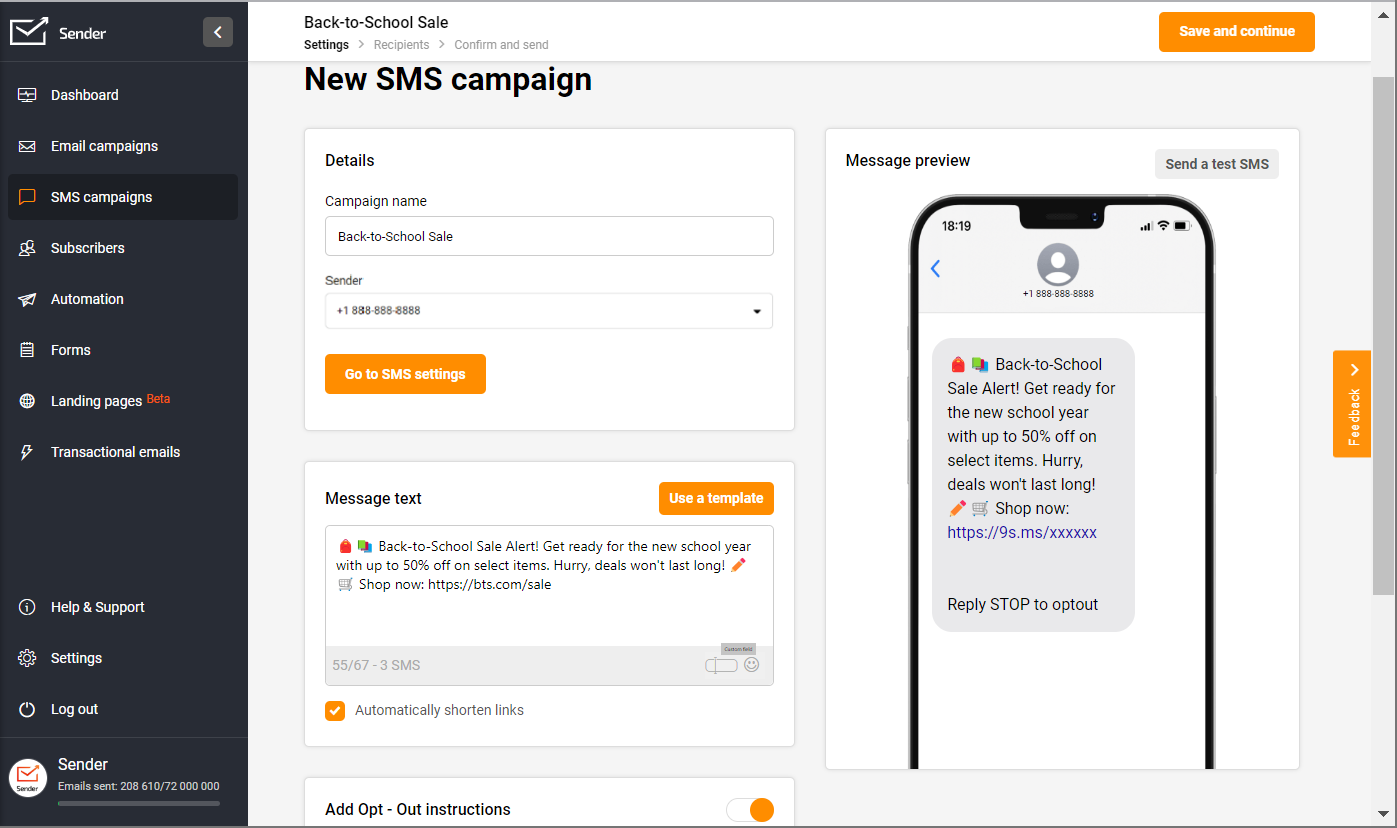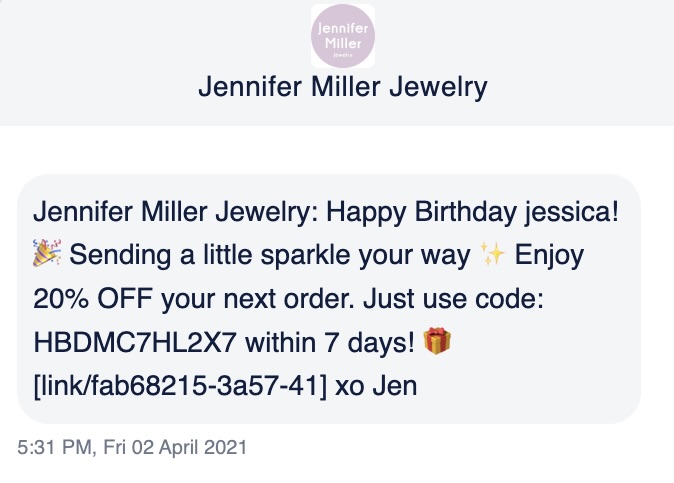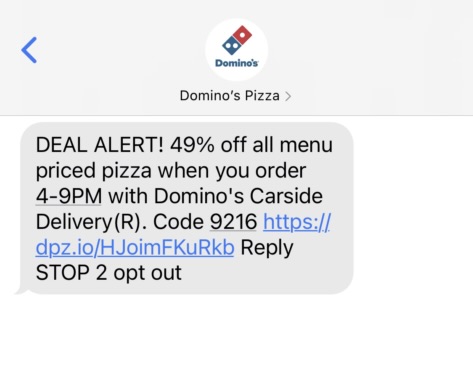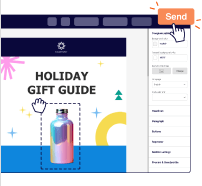Picture this: your phone buzzes, and within seconds, you’re in the loop – no internet needed, no apps to open. Welcome to the world of SMS notifications, the unsung hero of instant communication.
SMS notifications are not just for keeping you updated; businesses are all over them for many reasons.
Why, you ask? Aside from the obvious “Hey, something’s changed!” they’re marketing gold. They keep customers in the loop and ensure you’re the first thing on their minds.
So, are you ready to dive into the world of short message service? Let’s explore how to make SMS messaging work for your business, delight your customers, and even beef up your offers. Let’s get started!
What is an SMS Notification?
An SMS notification is a brief text message to inform individuals about updates, reminders, or alerts related to their accounts, services, or activities.
These nifty, short messages keep you in the loop, whether it’s a reminder, a sale, or an urgent update. And guess what? They cut through the noise directly to the prospect’s phone and offer great open and click-through rates.
If you’re thinking about what is an SMS alert and why it is the best way to engage the audience, here’s the lowdown:
- Instant impact. SMS text messages hit the user’s mobile phone almost instantly, perfect for those “need-to-know-now” moments;
- Everyone reads them. Unlike emails, which can stay unopened, texts get opened and read almost all the time;
- Universal reach. From old-school flip phones to the latest smartphones, SMS messages don’t discriminate. Everyone gets the memo;
- Wallet-friendly. They’re easy on the purse strings, offering a bang for your buck in reaching out to folks;
- Two-way street. SMS isn’t a one-way street; users can reply or take action straight from the message, boosting the interactive vibe.
So, whether you need to boost your engagement or stay connected, you should utilize SMS notifications to keep everyone in the loop, engaged, and ready to roll.
Are SMS Notifications Effective?
Do people still read texts? According to the most recent SMS statistics, SMS has much potential. It’s more than just old-school texting; it’s a goldmine waiting to be explored. Check out these eye-openers:
- 60% of customers read SMS messages and notifications within 5 minutes of receiving it;
- 33% of recipients react to CTAs within SMS, and 47% of them end up buying something;
- 78% of mobile phone users use their phones primarily for sending, answering, and checking text messages;
- 61% of smartphone users spend more time texting nowadays compared to 2020;
- 54% of customers prefer receiving promo SMS, but only 11% of businesses use SMS as a marketing medium;
- 66% of customers like to receive service-related SMS notifications, but only 23% of companies send SMS notifications;
- 59% of consumers prefer receiving direct SMS notifications from a brand to downloading a separate app for communications, offers, or messages.
Also read: 24 SMS Marketing Statistics You Must Know.
Here’s the deal: SMS notification is an underrated marketing tool most businesses overlook. It’s like a growth opportunity right under their noses, but they keep walking past it. Take this chance to get ahead of the curve and make the most of text messages.
Send messages that get noticed—SMS is quick, effective, and won’t break the bank!

When to Use SMS Notifications?
Think of SMS notifications as a direct line to your customers.
Imagine being able to whisper a reminder about an abandoned shopping cart or flash a sale notice directly to their screens. That’s the power of SMS – instant, personal, and incredibly effective.
Here’s how you can sprinkle some SMS magic into everyday marketing:
- Send appointment reminders. Send a timely reminder for upcoming appointments, meetings, or an event;
- Ecommerce updates. Send order updates or nudge customers with a friendly abandoned cart sms reminder about items waiting in their cart;
- Emergency alerts. Send critical security alerts or emergency messages to your subscribers or customers;
- Plan promotions. Drum up excitement with announcements for flash sales or limited-time deals;
- Inform or thank customers. Keep folks in the loop with updates on their order or send a warm “Thanks!” after a customer makes a purchase;
You can also use SMS to ask them to share their opinions, remind them of things they forgot, or regularly check their interests. The possibilities are limitless when you think of it that way, as you get an almost instant response.
Comparing SMS vs. Push Notifications
You must think, “What’s the difference between an SMS and a push notification?”. Think of both like a mobile messaging duo, each with its superpower for catching your attention. But how exactly do they differ? Let’s look:
- Getting the green light (opt-in). SMS is all about getting that thumbs-up. You need your customer’s number and a nod to proceed with those marketing texts. Push notifications play by the app’s rules—users can say “yes” or “no” to alerts when they download an app;
- How they land. SMS doesn’t need WiFi or data – it just zips straight to any mobile phone via good old cellular networks. Push notifications, on the other hand, are the internet-savvy cousin. They pop up on mobile phones, but only if there’s internet and the app is there to catch them;
- Impact. When push notifications pop up, they splash your screen, maybe even with a little jingle. But they’re like a shower of shooting stars – seen one moment and buried by others the next. SMS? It’s the message that sticks around. It lands in your inbox and stays put, waiting patiently for a re-read unless the user decides to clear it.
| SMS Notifications | Push Notifications | |
| Opt-in Process | Requires phone number and consent for marketing messages. | Users opt in or out via app settings after download. |
| Delivery Method | Delivered over a cellular network; no internet required. | Requires an internet connection and is received via a downloaded app on smartphones. |
| Visibility & Impact | Appears in SMS inbox; remains visible unless deleted. | Appears on screen with possible sound; can be quickly overshadowed by newer notifications. |
Exploring the Benefits of SMS Notifications
For ages, companies have relied on SMS to send crucial security updates and transaction alerts. But here’s the scoop: SMS marketing is starting to turn heads because of its impressive engagement stats.
Here’s why it’s a hit: We’re glued to our phones day and night, right?
So when you shoot off an SMS, it’s almost a lock that your customer’s going to see it. Plus, get this: as of 2023, a whopping 59% of people actually prefer getting texts straight from their favorite brands.
And the numbers don’t lie – texts just connect with us more. This is fantastic news if you’re looking to jazz up your marketing mix with something that gets noticed, like SMS:
- Boost your reach. Step into the world of omnichannel marketing with SMS. It’s like throwing open the doors to a whole new audience. Imagine blending SMS with other channels and watching engagement and sales skyrocket – we’re talking up to 250% higher engagement and conversion rates;
- Increase brand loyalty. Personal touches are like the golden goose of marketing. Shoot over a personalized SMS and watch customers engage more and turn more loyal. It’s all about making your customers feel special and seen. They’ll remember you – and keep coming back for more;
- Speedy sees and reads. Emails can get lost in the shuffle, but SMS? They land in no time flat. With 60% of texts opened within just five minutes, your message doesn’t just arrive; it intrigues a person, meaning more eyes on your content and more bang for your marketing buck.
Illustrating SMS Notification Examples
To get a real feel for how SMS notifications click, let’s peek into how the big brands do it. We’ll check out some real-deal SMS examples. After diving into these, you’ll spot a common thread – SMS marketing campaigns march to the same beat as traditional ones; they just cut to the chase a lot quicker.
Flash Sale Alert SMS by Meet Blume
Sending a time-sensitive flash sale SMS is a great way to drive engagement and traffic. The marketing team at Meet Blume probably got the memo when they crafted this no-nonsense flash sale SMS reminder. Here is an SMS notification example:
Blume: WHIRL FLASH SALE! Packed with Hyaluronic Acid, Prickly Pear Seed Oil + Aloe Juice, this light and fluffy moisturizer will nourish all summer long. Buy one, GET ONE FREE until midnight with code: FREEWHIRL. [link]

The simple, non-pushy tone and a time-sensitive promo code would have made their flash sale a huge success. The clever placement of all-caps text within the SMS surely would have grabbed eyeballs. You can also send a similar SMS to your audience whenever you plan a limited-time offer.
Birthday SMS Promo SMS by Jennifer Miller Jewelry
Sending a personalized birthday greeting via SMS is a great idea for making your customers feel loved. Jennifer Miller Jewelry uses birthdays to reach out and delight its users.
Jennifer Miller Jewelry: Happy Birthday, Jessica! 🎉Sending a little sparkle your way ✨Enjoy 20% OFF on your next order. Just use code: HBDMC7HL2X& within 7 days! 🎁 [link] xo Jen

The personal touch here is on point. The SMS starts with the first name and is signed off as if sent by a friend. Plus, the contextual birthday offer would surely make readers curious about what’s in store for them at a discounted price—a good way to make them feel loved, appreciated, and valued.
Promo SMS by Domino’s Pizza
Restaurants can use SMS in multiple ways. SMS campaigns can send booking confirmations, share discount offers, and notify about takeout deliveries. Domino’s uses SMS to promote its time-sensitive offers. Have a look:
DEAL ALERT! 49% off all menu priced pizza when you order 4-9PM with Domino’s Carside Delivery. Code [code]; [link]. Reply STOP 2 opt out

The simple SMS with a straightaway benefit for the customer is an on-point promotional tactic. Plus, the time sensitivity will make a reader act on it quickly, increasing the conversion rates from this SMS campaign.
Mobile Text Alert by Republic Bank
Text alerts are important updates related to your account, orders, or security sent by brands, businesses, or banks. These updates keep you alert and informed about critical things. Here’s an example of transaction alerts by Republic Bank:
Image source: Republic Bank
The alerts are sent every time someone makes a transaction in their account. It tells them available and updated balance. They could have also added the transaction amount to the SMS notification to make it more useful for the reader.
Emergency Mass Text Message by the Government of Japan
Emergency broadcasts or mass text messages are sent as warnings or alerts in the event of disasters or public emergencies. These are usually sent by the government as an SMS or broadcast to all the GSM mobiles. Here’s an example of a tsunami warning by the Government of Japan:
Image source: Government of Japan
The message alerts the reader about a potential Tsunami threat on the country’s east coast and advises them to move to higher ground. When sent in time, such alerts can save many lives and make citizens feel safer.
Getting Started with SMS Notifications Service
Jumping into the SMS notification service game? It’s a smart move in today’s mobile-first world.
Considering that 90% of mobile users glance at their texts within the first half-hour of receiving them, the urge to send a flood of messages might be strong. But hold your horses – effectiveness lies in the details. Here are some golden rules for nailing your SMS notification strategy:
- Get the green light. Before bombarding your subscribers with texts, get their permission through an opt-in on your app or website. Consent isn’t just polite; it’s a must for SMS notification services;
- Provide a backdoor to opt out. Just as vital as consent is the freedom to opt out. Make it easy by including a simple unsubscribe option in your messages. Whether it’s a link or a code to text back, clarity is king;
- Keep it snappy. Brevity is the soul of wit – and SMS. With just 160 characters, make every word count to hold your audience’s attention. Your SMS notification service should deliver punchy, clear messages;
- Stay true to you. Your SMS tone should mirror your brand’s voice across all channels. Consistency breeds familiarity, which in turn builds trust;
- Measure, tweak, repeat. Treat your SMS notification service like a science experiment. Analyze what’s hitting the mark and what’s missing. Adjust based on metrics like timing, wording, and offers to refine your approach and boost your SMS marketing success.
Keen on starting your first SMS campaign? Check out this interactive demo on how to set up a campaign using Sender.
Key Takeaways: SMS Notification Service
Sending SMS notifications is a great way to boost engagement and get instant attention for your promotions, offers, and products. When planning SMS notification campaigns, remember the following:
- Create thematic and real-time SMS campaigns that pique curiosity, inform users, or send real-time updates;
- Always personalize your SMS campaigns to make customers feel valued;
- Always ask for consent (opt-in) before starting to send SMS campaigns to your audience;
- Use marketing automation tools like Sender to schedule your SMS messages.
Also read:





